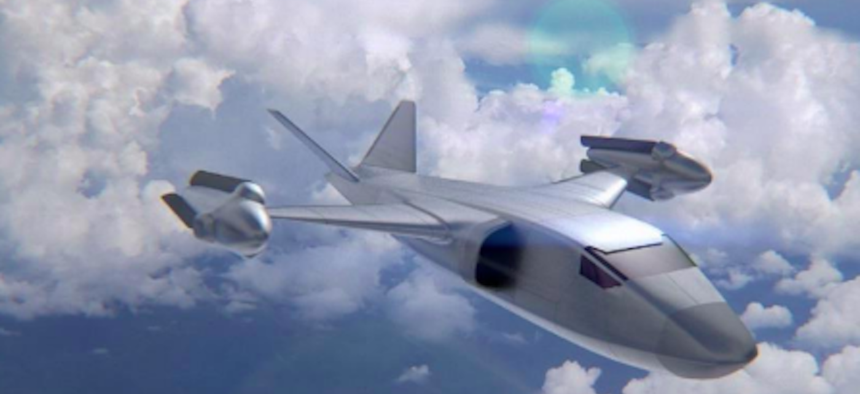
An artist's concept for the DARPA Speed and Runway Independent Technologies or SPRINT program DARPA Artist's Concept
DARPA To Launch High-Speed, No-Runway Aircraft Program
Will it be a helicopter? A seaplane? Or a whole new thing?
FORT WALTON BEACH, Florida–A high-speed aircraft that doesn’t need a runway is next on DARPA's drawing board, the research agency's director said Wednesday.
What will that look like? It could be a new form of helicopter, or perhaps a vertical-takeoff-and-landing aircraft that might fly even faster. But in her announcement, DARPA Director Stefanie Tompkins deliberately avoided calling the program a vertical-lift effort, and an accompanying slide displayed two artist’s concepts that were decidedly unhelicopter-like.

An artist’s rendering depicting two Speed and Runway Independent Technologies, or SPRINT, concepts from DARPA
DARPA is working with U.S. Special Operations Command on the new Speed and Runway Independent Technologies, or SPRINT, program, which will aim to build an air platform that shows a “combination of sort of runway independence and a sufficient level of speed and mobility,” Tompkins said. Those two concepts, she said, “have independently been explored by different communities and have different kinds of platforms, but not combined into a single space.”
She described some potential missions as emergency medical evacuation or helping troops infiltrate very-hard-to-reach areas. DARPA is “thinking very much about the people space,” in terms of scale, she said.
A new broad agency announcement on the program should come out within weeks.
The need for runway-independent aircraft for combat is growing as publicly available satellite imagery and open-source intelligence communities make it nearly impossible for militaries to hide runways or aircraft. Many analysts consider runways and airbases a particular vulnerability when it comes to a potential Chinese attack on Taiwan.
In a RAND memo from December 2021, Senior International Defense Researcher David A. Ochmanek described how a Chinese attack on Taiwan “might barrage Taiwan's airfields and air defenses, ports, big ships, lines of communication, and command/control systems with missile and air attacks before then loading up amphibious vessels for an assault on the island. With Taiwan's air defenses suppressed, the amphibious assault could be followed up with an airborne invasion by paratroopers and transport helicopters. China might well also strike American forces and bases in the western Pacific, to include aircraft carrier battle groups, aiming to cripple any U.S. effort to defend Taiwan.”
Earlier in the day, Lt. Gen. Tony D. Bauernfeind, the commander of Air Force Special Operations Command, highlighted the importance of aircraft that don’t require runways or large ground crews for future special air warfare operations. He cited SOCOM’s MC-130J seaplane concept as an example.
“Runway-independent operations like the MC-130 and high-speed [vertical take-off and landing] create a cost-imposing strategy on our adversaries by forcing them to defend everywhere, by injecting complexity and unpredictability into their decision-making processes,” he said. “Against near-peer or peer adversaries in contested or denied environments, our legacy architectures and technologies fall short.”
Thompkins and Bauernfeind made their remarks at the Gobal SOF Foundation Air Warfare Symposium.




